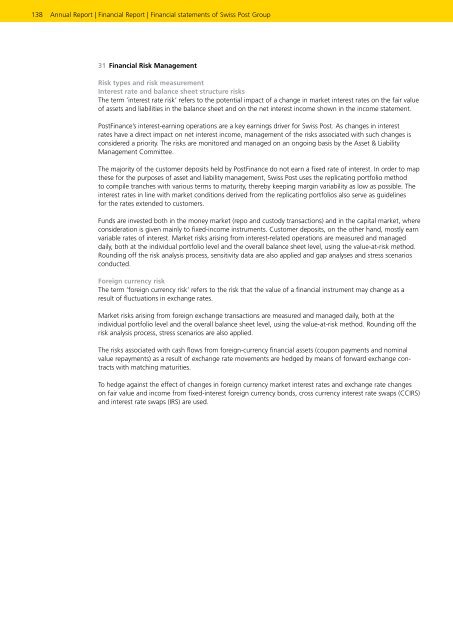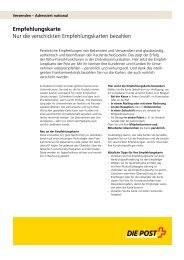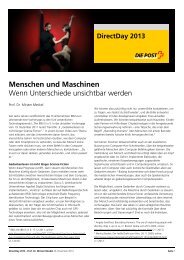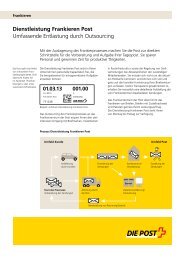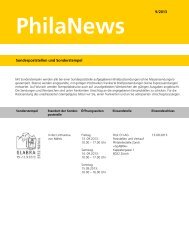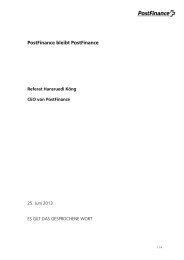Service-oriented - Die Schweizerische Post
Service-oriented - Die Schweizerische Post
Service-oriented - Die Schweizerische Post
You also want an ePaper? Increase the reach of your titles
YUMPU automatically turns print PDFs into web optimized ePapers that Google loves.
138 Annual Report | Financial Report | Financial statements of Swiss <strong>Post</strong> Group<br />
31 Financial Risk Management<br />
Risk types and risk measurement<br />
Interest rate and balance sheet structure risks<br />
The term ’interest rate risk’ refers to the potential impact of a change in market interest rates on the fair value<br />
of assets and liabilities in the balance sheet and on the net interest income shown in the income statement.<br />
<strong>Post</strong>Finance’s interestearning operations are a key earnings driver for Swiss <strong>Post</strong>. As changes in interest<br />
rates have a direct impact on net interest income, management of the risks associated with such changes is<br />
considered a priority. The risks are monitored and managed on an ongoing basis by the Asset & Liability<br />
Management Committee.<br />
The majority of the customer deposits held by <strong>Post</strong>Finance do not earn a fixed rate of interest. In order to map<br />
these for the purposes of asset and liability management, Swiss <strong>Post</strong> uses the replicating portfolio method<br />
to compile tranches with various terms to maturity, thereby keeping margin variability as low as possible. The<br />
interest rates in line with market conditions derived from the replicating portfolios also serve as guidelines<br />
for the rates extended to customers.<br />
Funds are invested both in the money market (repo and custody transactions) and in the capital market, where<br />
consideration is given mainly to fixedincome instruments. Customer deposits, on the other hand, mostly earn<br />
variable rates of interest. Market risks arising from interestrelated operations are measured and managed<br />
daily, both at the individual portfolio level and the overall balance sheet level, using the valueatrisk method.<br />
Rounding off the risk analysis process, sensitivity data are also applied and gap analyses and stress scenarios<br />
conducted.<br />
Foreign currency risk<br />
The term ’foreign currency risk’ refers to the risk that the value of a financial instrument may change as a<br />
result of fluctuations in exchange rates.<br />
Market risks arising from foreign exchange transactions are measured and managed daily, both at the<br />
individual portfolio level and the overall balance sheet level, using the valueatrisk method. Rounding off the<br />
risk analysis process, stress scenarios are also applied.<br />
The risks associated with cash flows from foreigncurrency financial assets (coupon payments and nominal<br />
value repayments) as a result of exchange rate movements are hedged by means of forward exchange contracts<br />
with matching maturities.<br />
To hedge against the effect of changes in foreign currency market interest rates and exchange rate changes<br />
on fair value and income from fixedinterest foreign currency bonds, cross currency interest rate swaps (CCIRS)<br />
and interest rate swaps (IRS) are used.


